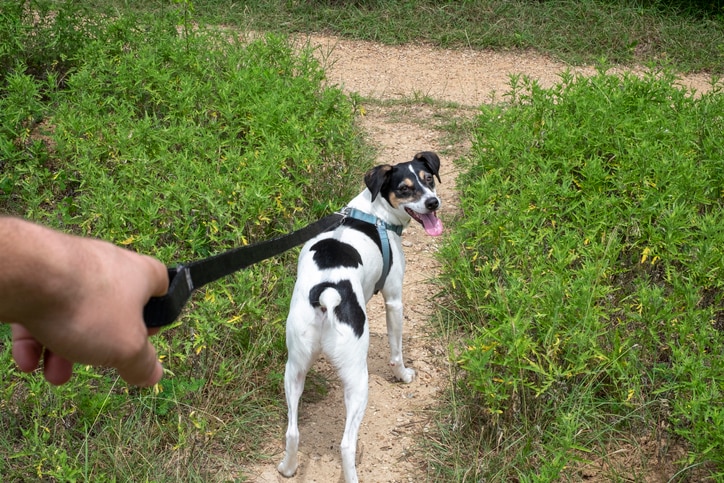Wait, didn’t your dog just ask to go out? Why are they standing by the door again, whining? Changes in your dog’s “bathroom” habits may or may not be a cause for concern — but how do you know when they are?
Several factors contribute to how often your dog needs to pee. The frequency might increase based on little things like your pet drinking extra water after a hot day at the park or after sneaking some potato chips. Or frequent urination in dogs might indicate a much bigger issue, such as a health problem.
So, if your dog pees a lot or you’ve been surprised by a sudden uptick in how often your pet needs to go out, keep reading. By learning what’s normal for your pet and paying attention to your dog’s pee schedule, you’ll be able to spot problems that may require a trip to the vet.
How often dogs pee normally
Knowing the average amount of times a typical dog pees will help you notice problems in your pooch. Dr. Donna Solomon, a veterinarian at the Animal Medical Center of Chicago, stresses that you should measure what is normal for your dog because dogs tend to favor routine and like to do things at the same time every day.
“A typical dog needs to urinate ‘once every four to six hours, although some will go eight and even 12 hours without needing to pee.'”
—Dr. Donna Solomon, veterinarian
A typical dog, she says, needs to urinate “once every four to six hours, although some will go eight and even 12 hours without needing to pee.” Dr. Krista Magnifico, a veterinarian and founder of the pet-related social network Pawbly, agrees. She says she has “many clients whose dogs can hold their urine for eight to 12 hours until their guardians get home to take them out” if they don’t have a pet sitter to let them out. She adds that the amount “can vary considerably based on diet, activity level, water intake and availability to appropriate bathroom accessibility.” Both veterinarians agree that size and breed don’t affect the number of times dogs pee in a day.
So, why is my dog peeing so much?
If you’ve noticed your dog peeing frequently and requiring more trips to their favorite bathroom spot, here are some possible reasons.
Puppies pee more often
Age does affect how often a dog needs to urinate. Puppies will need to go out more often — every two hours, according to Solomon — especially during house training. Puppy owner Meghan Smith of Mason, Ohio, says she takes her 3-month-old dog out “every hour, on top of every time he wakes up from naps, after vigorous play and within five minutes of eating or drinking anything.” Her previous dog Loki, she says, took two weeks to train, but this puppy is taking longer.
Sarah Carothers of Winston-Salem, North Carolina, says she’s the one being trained! Her 5-year-old dog Maxx goes to work with her, where she has to keep a close eye on him to avoid accidents in the office. She takes him out “at specific times — 8:30, 11, for lunch from 1 to 2, 4 and then home.”
Join Care for free
Age and medication can cause frequent urination in dogs
Older dogs might also need to urinate more frequently than average. Carothers’ dogs typically go out first thing in the morning when they leave their crates, before she leaves for work, when she comes home, after dinner and before bed. Her older dog, Coz, is now 13 and needs an extra potty trip around 4 a.m. He “is on heart pills, which make him pee more so he sometimes has an accident,” she explains, adding that she’s only comfortable leaving the dogs for about six hours.
A dog peeing a lot could signal a health issue
Frequent urination in dogs sometimes signals a health problem. “Increases in frequency can indicate a bladder problem, bladder infection, kidney disease, bladder disease, liver disease or diabetes,” says Solomon.
She adds that after a first snowfall, she notices that more dog owners tend to show up at her office with dogs that have urinary tract infections. “Many of these dogs have probably been harboring their UTIs for months. But that first pee in the new snow reveals dark, orange or even red urine and everyone comes running in.”
“Any changes in a dog’s frequency, urgency or ability, or discomfort urinating is cause for concern and warrants a trip to the vet.”
—Dr. Krista Magnifico, veterinarian and founder of Pawbly
When to call your vet
“If you notice your dog asking to go out more, that could be a red flag,” Solomon says. Pay close attention to the frequency, the color of the urine, the amount, the smell and whether your dog has discomfort when peeing. “Any changes in a dog’s frequency, urgency or ability, or discomfort urinating is cause for concern and warrants a trip to the vet,” says Magnifico.
Your vet might run tests on your dog’s urine for a diagnosis. The veterinarian will also ask questions about your dog’s peeing schedule and what changes you notice so they can ensure your pet is healthy and thriving.



